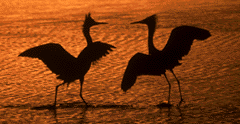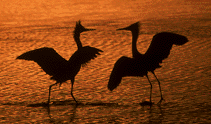 |
 |
||
Arthur Morris / Birds as Art
|
Home
|
General Bird Photography
Frequently Asked Questions
[ Back to Question List ]
What do you think of the Canon EF 100-400mm f/4.5-5.6L IS zoom lens?I finally got around to borrowing this new Image Stabilizer zoom lens in March and did some shooting on the beaches of southwest Florida. The lens performed well and--contrary to some early reports--proved to be exceptionally sharp, even when shot wide open at the 400mm focal length. Before I ever laid hands on this lens, I knew that it would be the ideal safari lens. Now, I know that I was right. The lens has a special ring that permits the adjustment of zooming friction from smooth to tight. Since I was using the lens first as a flight lens, I kept the lens at 400mm and the friction setting on "tight." Then, if I wanted to shoot at a shorter focal length, Iíd turn the ring to "smooth" and choose the focal length that I needed. Carrying this lens actually encouraged me to make many more images of groups of birds in their natural habitat than I usually do when carrying only fixed focal length telephoto lenses. Without changing my position, it was easy to frame and design an image that depicted a large group of terns and skimmers in the foreground, an even larger flock of Red Knots resting across a small channel, some beach vegetation, and small strips of both lagoon and sky. All in all, not the typical BIRDS AS ART image. The lens is more than adequate as a flight lens. With the Image Stabilizer mode turned on, initial focus acquisition is delayed for a fraction of a second. Therefore, when shooting flying birds on sunny days , I turn IS off. I made lots of excellent flight shots of Brown Pelicans. When working at the fishing pier on Sanibel Island, Iíd keep the friction ring on loose. It was a pleasure to be able to rack back to shorter focal lengths as the large birds flew right at me, sometimes almost close enough to grab as they landed on the roof of the shelter. At Blind Pass, I made a "family-jewels-quality" image of two Great Blue Herons fighting in midair at the 400mm focal length. The IS technology allows even inexperienced photographers to make sharp images at the 400mm focal length with shutter speeds as low as 1/125 of a second (using the IS 1 mode). Experienced shooters will be able to utilize even slower shutter speeds. If you absolutely abhor tripods, this is the lens for you. For shooting flight and action in less than full sun, be sure to choose the IS 2 setting; this allows you to pan with the subject. As for performance with the 1.4X TC, I suspect that loss of sharpness would be noticeable, but I have not tested this combination (nor do I plan to). Others have been happy with the results obtained when using this combination. With its 100 to 400 mm focal length range, this relatively inexpensive zoom lens is supremely versatile. Anyone who shoots sports, travel, general nature, photojournalism-- hell, just about anything--would be able to use this lens a great deal. And if you ever shoot wildlife from a boat of any kind, it is surely incomparable. For general photography, this lens--in combination with the superb Canon EF 28-135mm IS zoom lens--would cover all bases and eliminate the need for a tripod for all but macro photography. (I forgot to mention that the 100-400 IS zoom has an excellent minimum focusing distance of 5.9 feet, making it useful for large flowers, butterflies, etc..) On the negative side, at about three pounds, the 100-400 IS zoom lens is fairly heavy. Bird photographers carrying this lens afield along with a tripod-mounted super-telephoto lens might consider using an A2 series or Elan II body (rather than an EOS 3 or 1N) with the 1-4 zoom in an effort to save weight. I will use this lens only occasionally. I prefer, instead--for everyday bird photography--to carry my beloved "toy lens" (the Canon EF 400mm f/5.6L) on my shoulder as a flight lens, and storing the 28-135 IS zoom in a vest pocket for grab shooting. If you are not, however, as narrowly focused as I am, this might be an ideal addition to your lens arsenal. [ Back to Question List ]
[ Birds As Art Home ]
|
